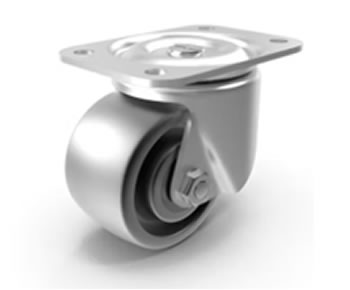Rigid Casters
Rigid casters are a type of caster commonly used in various applications to provide stability and straight-line movement. Unlike swivel casters, which can rotate 360 degrees, rigid casters do not swivel. They are designed to move in a fixed direction, making them ideal for specific tasks and situations where precise control and stability are essential.
Features of Rigid Casters
Rigid casters have several distinct features that set them apart:
- Fixed Direction: Rigid casters are fixed in one direction and do not rotate. This makes them suitable for applications where movement in a straight line is required.
- Stability: Rigid casters provide excellent stability, making them ideal for supporting heavy loads and equipment that should not wobble or change direction unintentionally.
- Simple Design: Rigid casters have a straightforward design with a single wheel mounted on an axle. This simplicity enhances their durability and load-bearing capacity.
- Easy Maintenance: Due to their uncomplicated design, rigid casters are easy to maintain and typically require less maintenance compared to more complex caster types.
Applications of Rigid Casters
Rigid casters find use in a variety of applications across different industries, including:
- Industrial Carts: Rigid casters are often used in conjunction with swivel casters to create a combination that offers both mobility and stability for industrial carts carrying heavy loads.
- Material Handling Equipment: Rigid casters are commonly found on material handling equipment such as dollies, platform trucks, and hand trucks, where maintaining a straight path while moving is essential.
- Assembly Lines: Assembly lines in manufacturing often utilize rigid casters on workstations and conveyors to keep components or products moving in a fixed direction.
- Racks and Shelving Units: Rigid casters provide support and stability to racks and shelving units used in warehouses, retail spaces, and industrial facilities.
Advantages of Rigid Casters
Rigid casters offer several advantages in the right applications:
- Stability: Rigid casters excel in maintaining stability and control, ensuring that equipment or loads move predictably without swaying or changing direction unintentionally.
- Load Capacity: They are often chosen for their high load-bearing capacity, making them suitable for heavy-duty tasks and applications.
- Cost-Effective: Rigid casters are typically more affordable than swivel casters, making them a cost-effective choice for specific applications.
- Durability: Their simple design contributes to their durability, reducing the likelihood of breakdowns or maintenance issues.
Considerations When Using Rigid Casters
While rigid casters offer stability and load-bearing capabilities, there are some considerations to keep in mind:
- Maneuverability: Rigid casters do not provide the same maneuverability as swivel casters. When precise maneuvering or changes in direction are required, a combination of both types may be necessary.
- Floor Protection: Depending on the wheel material, rigid casters may not provide the same floor protection as softer wheels found on swivel casters. Consider the flooring type when selecting casters.
Rigid casters are a valuable component in many applications, offering stability and control when moving loads in a straight line. Understanding their features and applications can help you make informed decisions when choosing casters for your specific needs.










